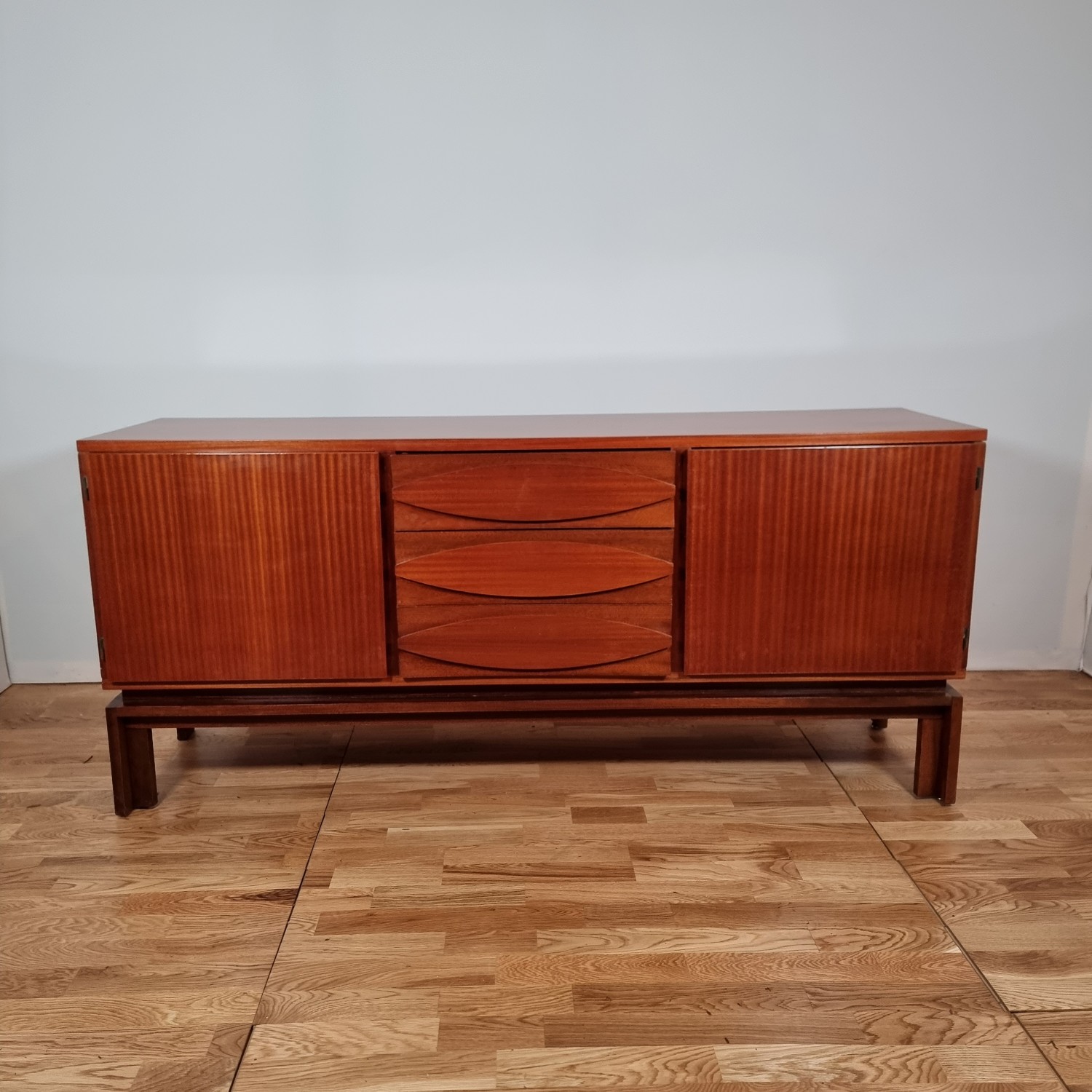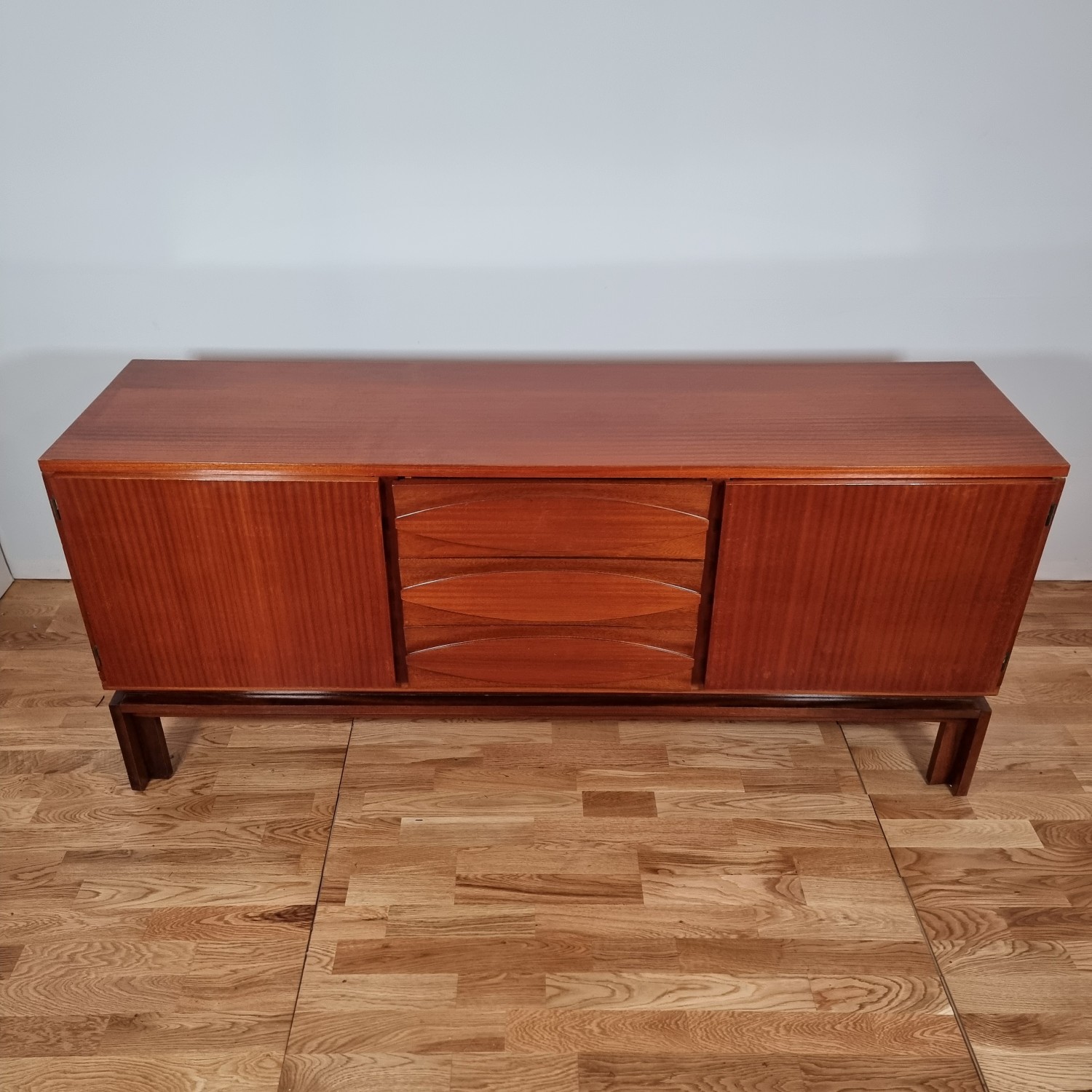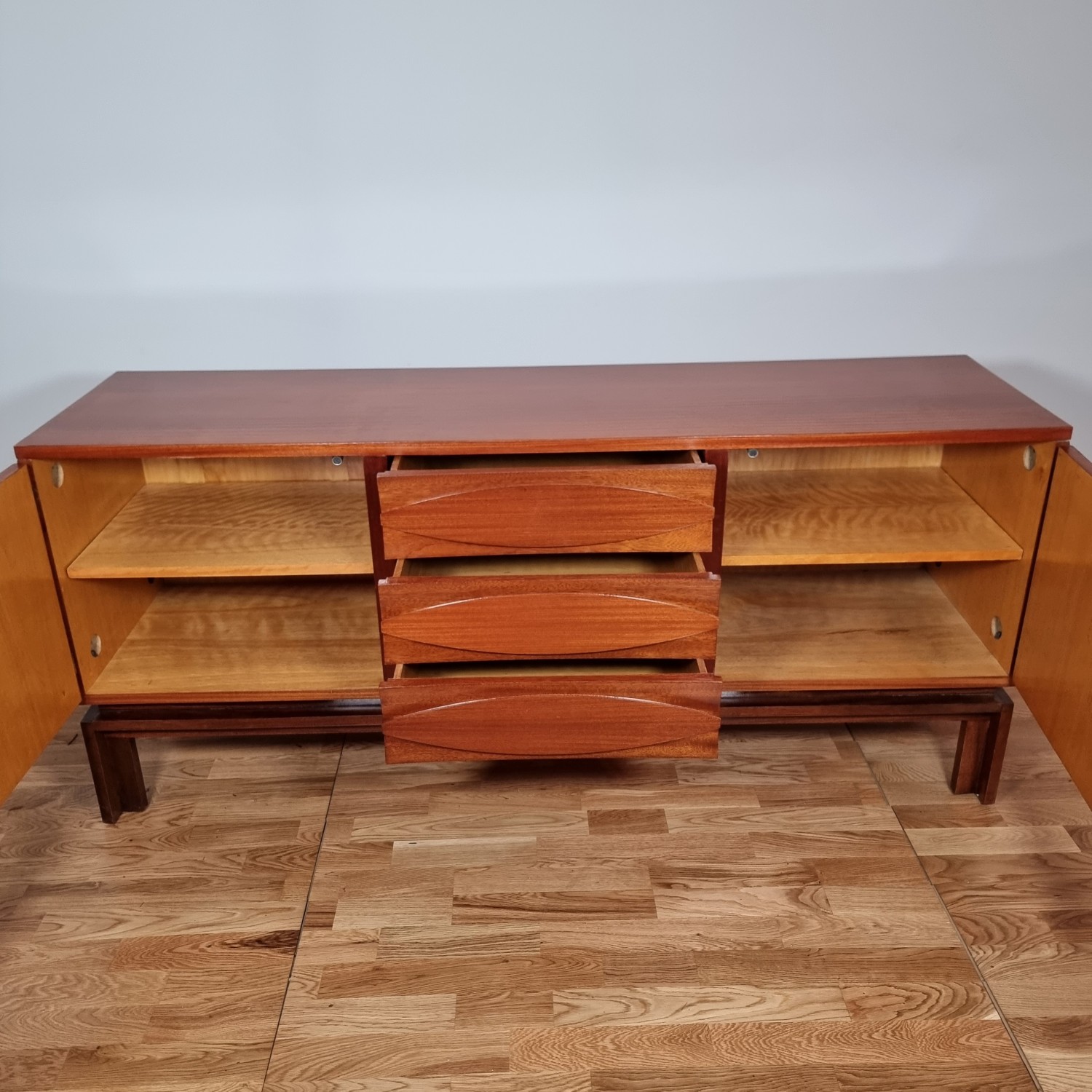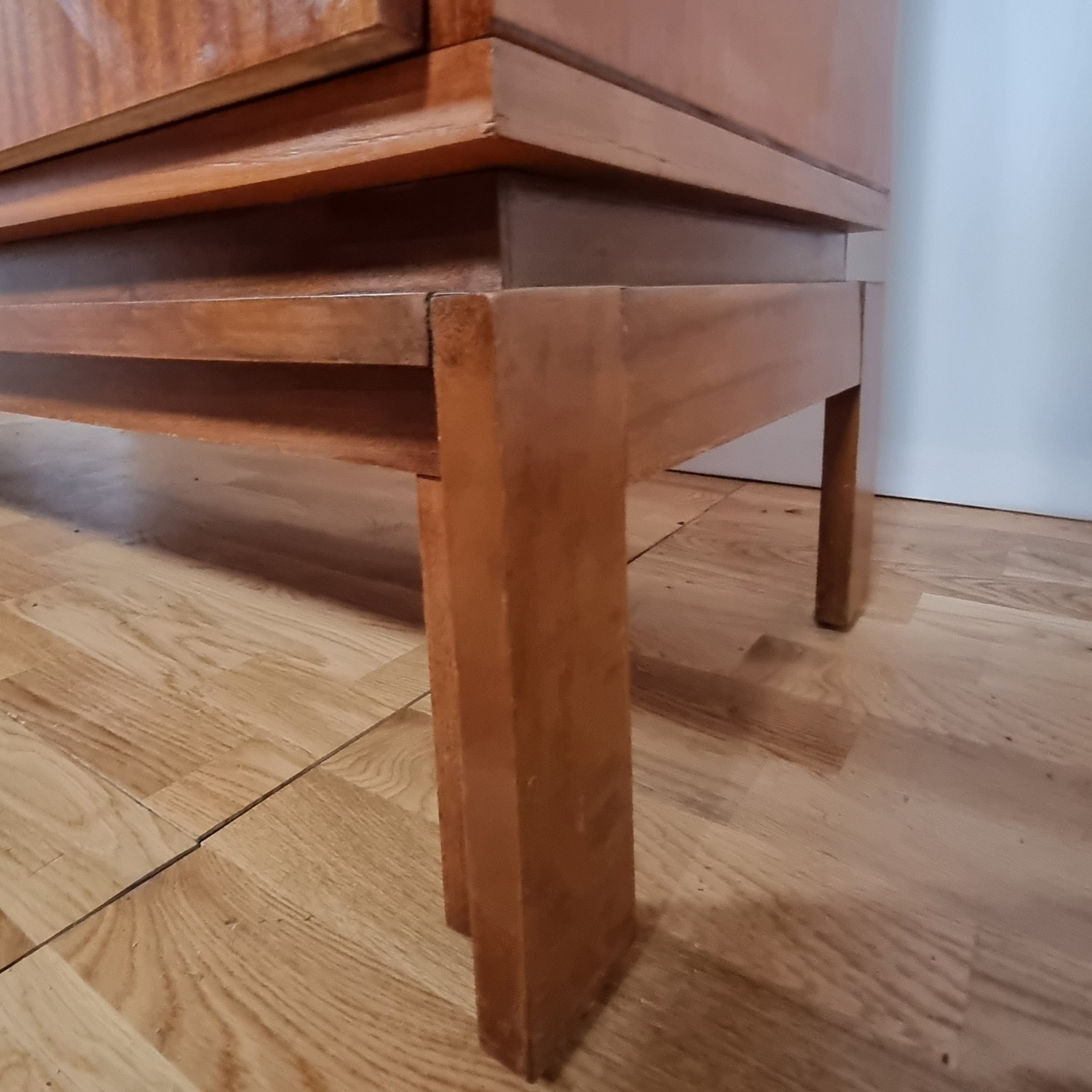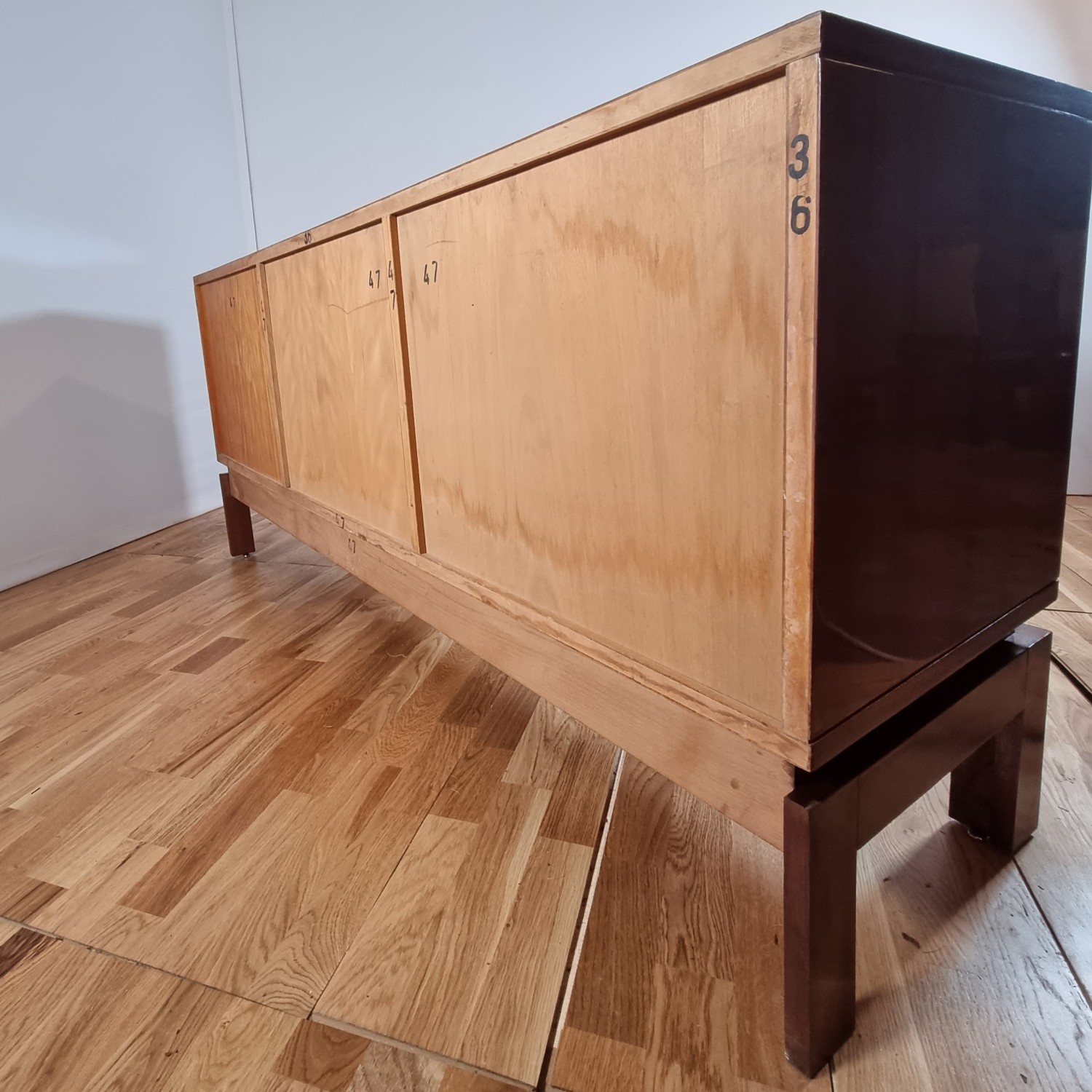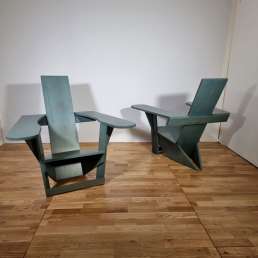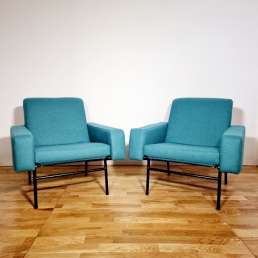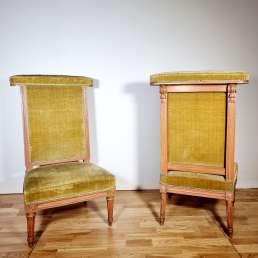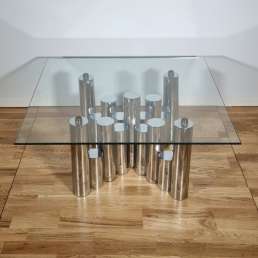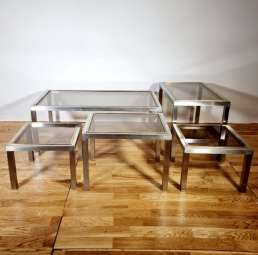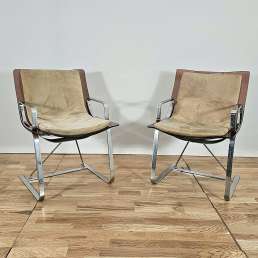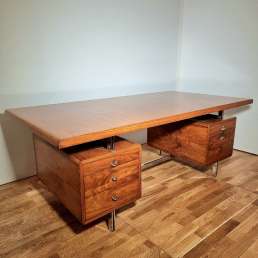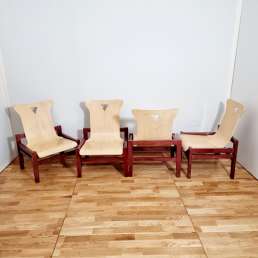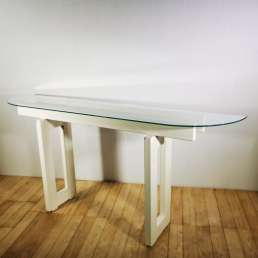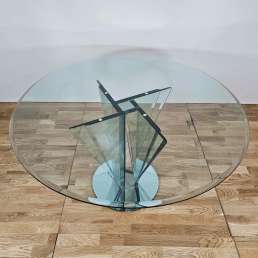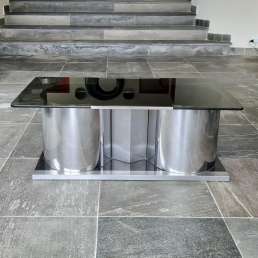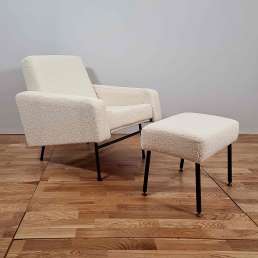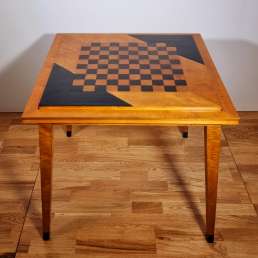Mahogany sideboard by Joseph-André Motte for Les Huchers, circa 1960
Description
What I like
I like this sideboard because it has very clean lines, both drawn and purified: the lower part, with this modernist molding, totally lightens the design of this sideboard.
The balance between the supporting structure, minimalist, and the rectangular sideboard part is spectacular. And I like that, in this purity, the facade is enlivened in its center by these three ovals which also have a practical use: they are hand grips. Even the decor is useful but extremely innovative: we obviously think of the success of geometric abstraction of this period, with André Bloc, Jean Dewasne, André del Marle, Edgard Pillet, who announced Vasarely! Of course, one reminds the success of the Chapo’s Eye table, a little bit later.
I like the fact that the creator of this sideboard is part of the trio that created the Atelier des Recherches Plastiques, which worked between 1954 and 1957: Joseph-André Motte, Pierre Guariche, Michel Mortier, who renewed the creation of furniture in France from the 1950s.
I like the quality of this sideboard produced by a small publishing house, the Huchers, of course, but which relies on quality: in particular the mahogany used and the impeccable assembly. Les Huchers is known for having encouraged great designers to offer innovative and quality furniture, including those of the A.R.P. (Atelier des Recherches Plastiques), before uniting its destiny with the Minvielle house, which used the same designers, in 1961!
Technical description
Joseph-André Motte for Les Huchers, circa 1960
Sideboard in mahogany and varnished mahogany veneer, the rectangular body opens with two doors revealing an interior in light oak veneer with a shelf, on either side of three drawers whose front is decorated with an eye or shuttle motif in relief forming a grip. The base has a strong play of modernist moldings on the front.
Lack of oak veneer at the back in the right part, tiny lack of mahogany veneer on the left rear of the base.
Bibliography: a slightly larger row is reproduced in the magazine “La maison française” of October 1958, p.11, indicating the name of the creator and the publishing house.
Dimensions and weight
Height: 78 cm – Width: 171 cm – Depth: 47 cm
Weight: 50kg
Mix & Match
Above this beautiful sideboard, I would hesitate between the geometric rhythm (interrupted circles, but also slight inflections, which recall the ovals of the sideboard) of our beautiful Composition by Edgard Pillet, earlier, since it dates from 1950-1951; or the large, colorful flat areas of Daniel de Linière’s tapestry, Nuit d’Espagne. A beautiful lamp is a must: why not the Idra lamp by RobertoToso for Leucos in Murano glass, whose shuttle section will play with the handles of the drawers: it will bring a dreamlike note, with its blue murini on a white background.
We may prefer the very large lamp by Dijkstra Lampen, in ceramic with a beautiful thick speckled white and beige enamel, impressive for its height and that of its cylindrical lampshade, the period of its creation corresponding to that of our sideboard: same purity geometric lines, even attention to quality.
I would also place in front of this row the pair of G10 armchairs by Pierre Guariche for Airborne: same period of creation, same lines so pure but constructed, also with a refined touch. But to tell the truth, the lounge chair and its Rock Royal ottoman by Sven Dysthe would make a refined counterpoint to this sideboard: their lines equally mix curves (seat) and straight lines (base).
For a completely different atmosphere, you can opt for the very sculptural Adirondack armchairs by Philippe Parent: here too, the curves of the armrests and the straight lines of the backrest, seat and base will respond to the lines of our sideboard: they would add a bright green glow!
In stock
Description
To know more
The designer
Joseph-André Motte, born in 1925, died in 2013, is a French designer, decorator and interior designer.
In 1948, Joseph-André Motte graduated top of his promotion from the school of arts applied to industry, today ENSAAMA. Among his teachers are René Gabriel and Louis Sognot. He began his career at the Bon Marché art studio. In 1954, he co-founded the Plastic Research Workshop (ARP) with Pierre Guariche and Michel Mortier. He also works within Group 4, formed with René-Jean Caillette, Geneviève Dangles and Alain Richard. Motte made a name for itself thanks to a woven rattan armchair known as a “tripod”, whose shell shape suited all bodies. From the 1950s, he collaborated with the furniture manufacturer Steiner, with the houses Les Huchers and Minvielle, as well as with a few other publishers.
His agency worked on major public commissions such as the interior design of Orly airport from 1958 to 1961, the maritime station in Le Havre from 1963 to 1964 or the decoration of the prefecture of Cergy-Pontoise in 1970 and the Paris Charles de Gaulle airport (Roissy 1 and 2). He fitted out Paris metro stations on an order from the RATP placed in 1973. Motte brought a new style, known as “Andreu-Motte”, characterized by white tiling, benches and lines of colored lighting along the quays breaking radically with the “Mouton” style and its orange tiling. In particular, he designed a seat that was to become emblematic of the metro, by creating the individual shell seat, which still equips many Parisian metro and RER stations today.
Motte chaired the society of decorative artists from 1966 to 1968. He taught for thirty years at the National School of Decorative Arts and was responsible for conferences at the Boulle school and the Camondo school.
Despite his fame in the designer world, Motte is still little known to the general public for the moment.
The shapes of the furniture created by Joseph-André Motte revisit the classic, while remaining simple and accessible to the general public and always taking great care in the choice of materials.
Motte received the René Gabriel Prize in 1957 and the Compasso d’Oro Prize in 1970.
The editor
Les Huchers-Minvielle is the merger of the furniture distribution network “Les Huchers” with the furniture editor Minvielle in 1961.
From the 1950s, Minvielle produced modernist furniture, including the famous element system designed by the A.R.P. (Atelier des Recherches Plastiques) and the other pieces of furniture created by the A.R.P.
The Huchers, at the same time, call on the same team of designers, for a quality but very innovative production; they distribute the production of Minvielle furniture.
Plastic research workshop (1954 – 1957)
ARP is an ephemeral association of three creators (Michel Mortier, Joseph-André Motte and Pierre Guariche) whose objective is to offer French manufacturers innovative furniture from a technical and stylistic point of view.
The ARP was created in October 1954. The creations are distributed in the Charles Minvielle and Huchers stores. In 1955 the group won the prizes of the series furniture competition at the SAM. If the whole testifies to a homogeneous aesthetic, each creator remains identifiable. The seats presented are produced by Steiner, in particular the Tonneau chair designed by Guariche and the Corb armchair by Motte; the furniture, including the famous storage elements designed after a Mortier prototype, is manufactured by Minvielle or by the more exclusive Huchers; the luminous coffee table is produced by Disderot and the Radar armchair by Airborne, both based on models by Joseph-André Motte. In 1957, after having signed creations of great diversity, each created his design office.
A beautiful and authentic sideboard at a fair price
This sideboard by Joseph-André Motte has been carefully selected for its aesthetic qualities, its originality and its fair price. Our choice favors above all the acuity of the design, of which the signature of J.A. Motte is the guarantee, guarantee of a valorization of your new acquisition in your interior and of an ability to dialogue with your furniture, to agree and to mix to create a unique decoration. On the other hand, the quality of its publisher, Les Huchers, guarantees its manufacturing quality, and therefore its longevity!
Buying vintage furniture is surely a reasonable investment, so great is the appetite for the 1960s.
Finally, buying vintage furniture preserves the resources of planet earth.
Additional information
| Weight | 50 kg |
|---|---|
| Dimensions | 171 × 47 × 78 cm |
| Créateur | |
| Editeur | |
| Epoque | |
| Matières |


